MXA’S 2015 YAMAHA YZ250F MOTOCROSS TEST: SPRING INTO ACTION
Q: FIRST AND FOREMOST, IS THE 2015 YAMAHA YZ250F BETTER THAN THE 2014 YZ250F?
A: Yes; however, the 2015 YZ250F is not exceptionally better than last year’s model. The refinements to the overall package have raised the bike to a new level, and these minor improvements can be felt by a sensitive rider. And, even the most maladroit will appreciate that accessing the air filter no longer requires the skill set of a safe-cracker.
Q: HOW MANY CHANGES WERE MADE TO THE 2015 YAMAHA YZ250F?
A: We didn’t expect any changes, given that the YZ250F was new from the ground up in 2014. But, Yamaha targeted durability, rider comfort, engine performance and showroom appeal.
(1) Engine. The YZ250F engine is different from any other 250 four-stroke. It is the only down-draft, front-intake, rear-exhaust, symmetrical-port, canted-rearward engine in the class. Yamaha believes wholeheartedly that its engine layout is more efficient at filling and scavenging the combustion chamber. And why argue? The YZ250F’s four-valve engine produces excellent horsepower at midrange, along with aggressive torque down low.
Yamaha upped the ante in 2015 with slight updates to the engine platform. A new exhaust cam moves the decompression pin by 6 degrees to reduce kicking pressure for easier starting (though we never encountered any starting issues on the previous model). The exhaust valve’s stem ends have an updated treatment to reduce wear and long-term clearance changes. Additionally, the piston’s ring land has been reconfigured to reduce oil consumption while improving lubrication. As for the transmission, the gear stopper lever has been changed to a solid, positive, roller-type design. Also the water pump shaft has been improved to solve the breakage issues of the 2014 model.

(2) ECU. Yamaha recalibrated the fuel injection and ignition timing to provide more control at low rpm. There is also broader midrange torque and smoother over-rev. A lighter throttle return spring creates 20 percent easier throttle pull.
(3) Airbox. Praise to Yamaha’s engineers, as they addressed one of YZ-F riders’ biggest pet peeves. Quarter-turn Dzus fasteners have replaced the hex-head bolts used on the airbox cover. Accessing the 2015 YZ250F filter is a breeze and can be done in a fraction of the time it took last year.
(4) Suspension. Kayaba’s Speed Sensitive System (SSS) suspension returns for 2015 and comes with revised fork settings. Yamaha’s in-house test crew focused on improving the balance and stability of the YZ250F. An increase in high-speed rebound and compression damping have been addressed. Fork oil volume has been increased by 5cc, and the low-speed compression has been reduced.
(5) Aesthetics. Gone are the silver Excel rims; in their place are black-anodized rims for a more race-inspired look. The YZ250F also receives a gold D.I.D. chain with corrosion-resistant plating. Back by popular demand are the impervious in-mold graphics—only with a new design—embedded into the plastic.
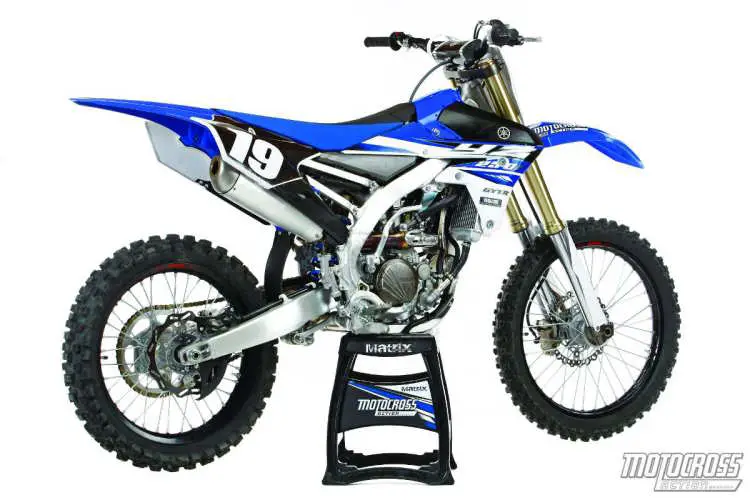
Q: WHAT CHANGES WERE WE HOPING THAT YAMAHA WOULD MAKE TO THE 2015 YZ250F?
A: Since we didn’t foresee monumental changes to the 2015 Yamaha YZ250F, the fact that Yamaha addressed a number of our quibbles on the 2014 model—notably airbox access and chassis balance—were bonuses. We are pleased with the YZ250F’s updates, even though the list is short.
For over a decade we lambasted Yamaha’s engineers for their inability to take any technological leaps forward with the YZ250F. The YZ250F stayed pretty much the same for 12 years. As fond as the MXA test crew is of the proven Keihin FCR carburetor, the YZ250F was getting leapfrogged over by the competition because the bike had stagnated. All that changed last year.
For 2014, Yamaha answered our wishes and went the extra mile. The 2014 YZ250F underwent a metamorphosis. The 2015 model shows that Yamaha’s engineers listen to the buying public. Revised fork settings? Yep. Better chassis balance? No problem. Easier access to the air filter? Done.
Q: WHAT IS THE MOST IMPRESSIVE TRAIT OF THE 2015 YAMAHA YZ250F?
A: There are several reasons why the Yamaha YZ250F was at the tops in the 250 Nationals last summer. You can argue that Jeremy Martin, Cooper Webb and Christophe Pourcel race a radically different version of the YZ250F, but that’s not entirely true. Martin and the oddly named (and horrendously spelled) Yamaha bLU cRU support program may have access to modified equipment, but they start with the same basic engine and chassis platform as the rest of us. The 2014 model was the best YZ250F produced to date, and the 2015 model builds on that accolade.
What is the most impressive trait of the 2015 Yamaha YZ250F? Plain and simple, the engine. From an engineering standpoint, the YZ250F layout is a marvel. The cylinder is slanted rearward for less gyroscopic effect. The 44mm Keihin throttle body uses a downdraft intake tract to maximize fuel delivery. The wraparound exhaust system achieves the required tuned length without gobbling up valuable space.
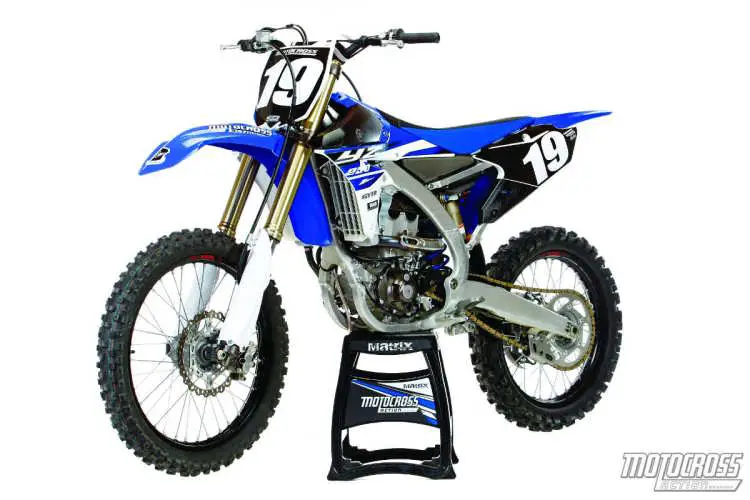
Most important, the YZ250F engine is fast. The powerband has a remarkable chunk of bottom-end gusto, a midrange that very well could be best in the class, and just enough top-end power to hold its own (there is a slight increase in over-rev from last year). It’s not mandatory to keep the rpm in the midrange—that is to say between 8000 rpm and 10,000 rpm—but it just so happens that the YZ250F works best in this ballpark. It is a Novice-friendly powerband, but it is also more than capable of running at Expert speed.
We would be telling a white lie if we said that the YZ250F engine is a jack of all trades. Why? The spread is broad, but it is lacking in the upper reaches where the fastest of the fast live. Failing to shift before hitting the rev limiter hinders forward progress, unlike what test riders like about the 2015 KTM 250SXF high-rpm shrieker. Then again, the YZ250F performs better everywhere else. The real question is not how fast you are, but how great your understanding of rpm dynamics is. It’s possible to shift late, with the caveat that an overzealous throttle hand overloads the powerband; but, whatever you do, don’t shift down too early entering corners. Unfortunately, the YZ250F is a victim of excessive engine braking, which puts a load on the suspension and changes the handling characteristics.
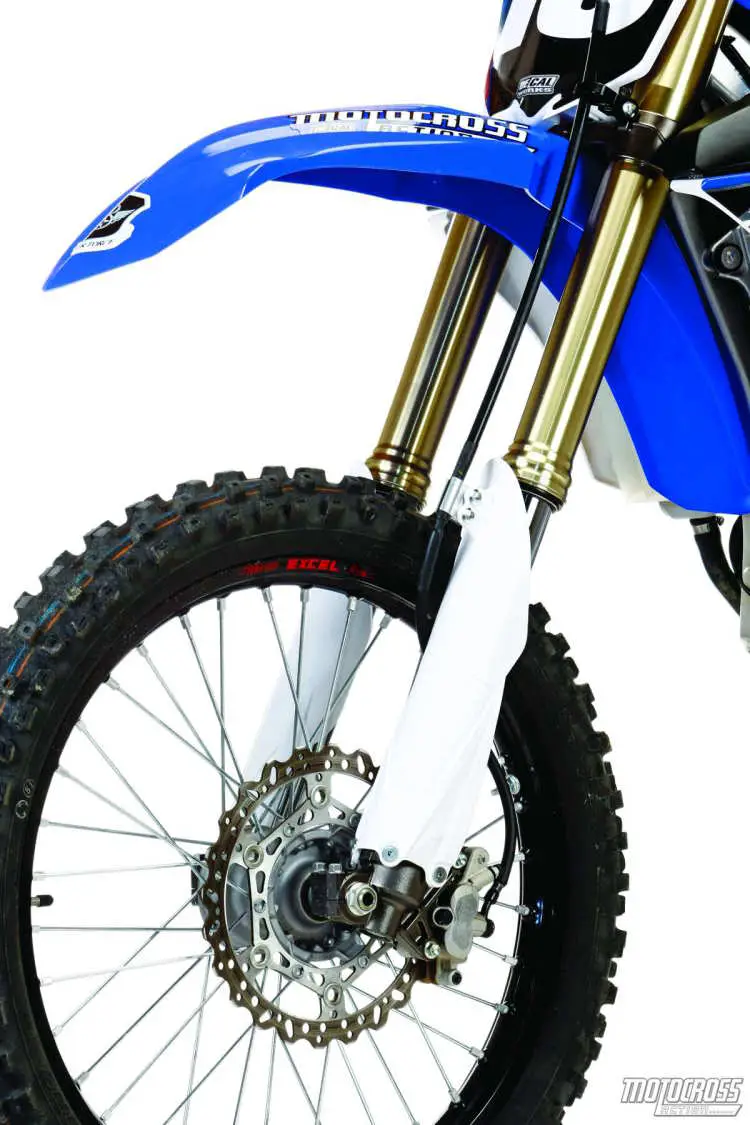
Q: IS THE KAYABA SSS SUSPENSION OUTDATED?
A: Not to our way of thinking. Call us old-fashioned, but we are still big proponents of Kayaba’s SSS suspension. It may not be deemed cutting edge in the highfalutin’ world of air forks, but the proof is in the pudding. The YZ250F suspension is the cream of the crop for a multitude of reasons. Let us remind you why.
(1) Dummy-proof. You don’t need to meticulously check various air chambers with the YZ250F forks. An air pump isn’t necessary. It’s not stretching reality too far to suggest that many modern riders won’t click a clicker, let alone set up three different air chambers. With the Kayaba SSS fork, you merely jump on the bike and go. No guesswork. Plus, coil springs never go flat.
(2) It works. MXA test riders aren’t naive. We know that an air fork, when set up properly, has the potential to be a superior product. The same, however, can be said for that bucktooth girl in the back of your history class. It’s a question of how much time and effort you want to put into the project. To our way of thinking, the Kayaba SSS fork is already a prom queen. Clicker changes are noticeable, and there are very few weak areas in the stock setup. We loved the SSS suspension when it was first introduced in 2005, and in the decade since, our love has only grown deeper.
Q: WHAT DO WE THINK ABOUT THE 2015 YZ250F’s HANDLING?
A: Since Yamaha unveiled the radically new 2010 YZ450F, we’ve had issues coming to terms with the odd handling characteristics of the big-bore YZ450F thumper. Straight-line stability was never the issue. Instead, we struggled to get the YZ450F to corner properly. Turn-in was vague, which caused riders to oversteer in the middle of the corner, followed by a countering effect upon exit. You don’t need Sherlock Holmes to tell you that the MXA wrecking crew has never been a fan of the YZ450F’s frame geometry. What does this have to do with the 2015 YZ250F? Everything and nothing.
Did you know that Yamaha uses the same frame layout on both the YZ450F and YZ250F. Even Doctor Watson could surmise that the YZ250F should handle just like the YZ450F. It’s elementary. Guess again. Perhaps it’s due to the smaller cubic displacement engine, decreased rotating mass or lighter overall weight, but the YZ250F is the superior-handling bike in Yamaha’s four-stroke line. It doesn’t hunt and peck at the entrance of turns like the YZ450F. Instead, the YZ250F’s front end is planted, tracks well at tip-in, and stays low in ruts.
Beware, we aren’t saying that the 2015 YZ250F is the best-handling bike in the class. It isn’t. In stock trim, the balance is slightly askew due to a more rear-end weight bias, which makes the front end drift on hardpack. But, by raising the sag, changing the fork-leg height and dialing in the clickers, you can make the chassis worthy of the engine.
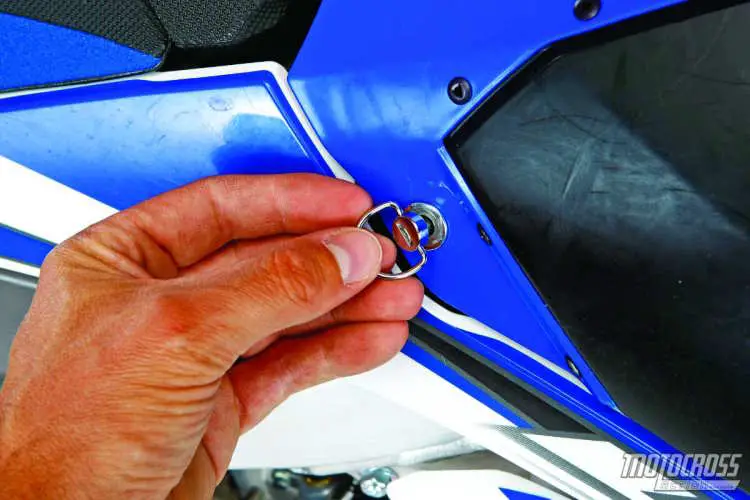
Q: WHAT DID WE DO TO IMPROVE THE 2015 YZ250F?
A: Find satisfaction by making these changes:
(1) Mapping. GYTR, Yamaha’s in-house development subsidiary, developed the Power Tuner for EFI-equipped Yamaha models. It’s a must-have item. We were able to improve the YZ250F powerband by changing the ignition and fuel-mapping settings. The Power Tuner does not boost horsepower; instead, it changes the power delivery. It particularly comes in handy when dialing in the engine after installing an aftermarket pipe. Available at your local Yamaha dealer, the GYTR Power Tuner ($279.95) is worth the investment.
(2) Front brake. The YZ250F front brake has quickly become outclassed by the competition. KTM has held the distinction of having the best front brake for years, and now the 2015 Kawasaki and Honda have invested in larger rotors. On the other hand, Yamaha’s front brake is terminally late to the party. Do yourself a favor and spend the dough on an aftermarket front-brake kit. We’ve had good luck with the Moto-Master Flame (www.moto-masterusa.com), Galfer Tsunami (www.galferusa.com) and Braking Batfly (www.braking.com) rotors.
(3) Air filter. As happy as we are that Yamaha went to Dzus fasteners on the airbox cover, we don’t like the built-in air filter backfire screen. It hinders performance and creates a whirring sound as air passes through it. Twin Air makes a Powerflow kit (www.twinairusa.com, $259.95) that replaces the stock filter cage with a sturdy aluminum unit. A flame-retardant air filter is also included. Testers noticed an improvement in throttle response, and the annoying intake sound was eradicated.
(4) Exhaust. Last year we conducted a six-pipe Yamaha YZ250F exhaust shootout (in the July 2014 issue). Surprisimgly, the stock exhaust was excellent, but there were better options. Vet riders favored the DR.D and HGS systems, Novices chose the stock and FMF systems, Pros raved about the Pro Circuit system, and every test rider agreed that the Yoshimura system was best for the widest range of skill levels.
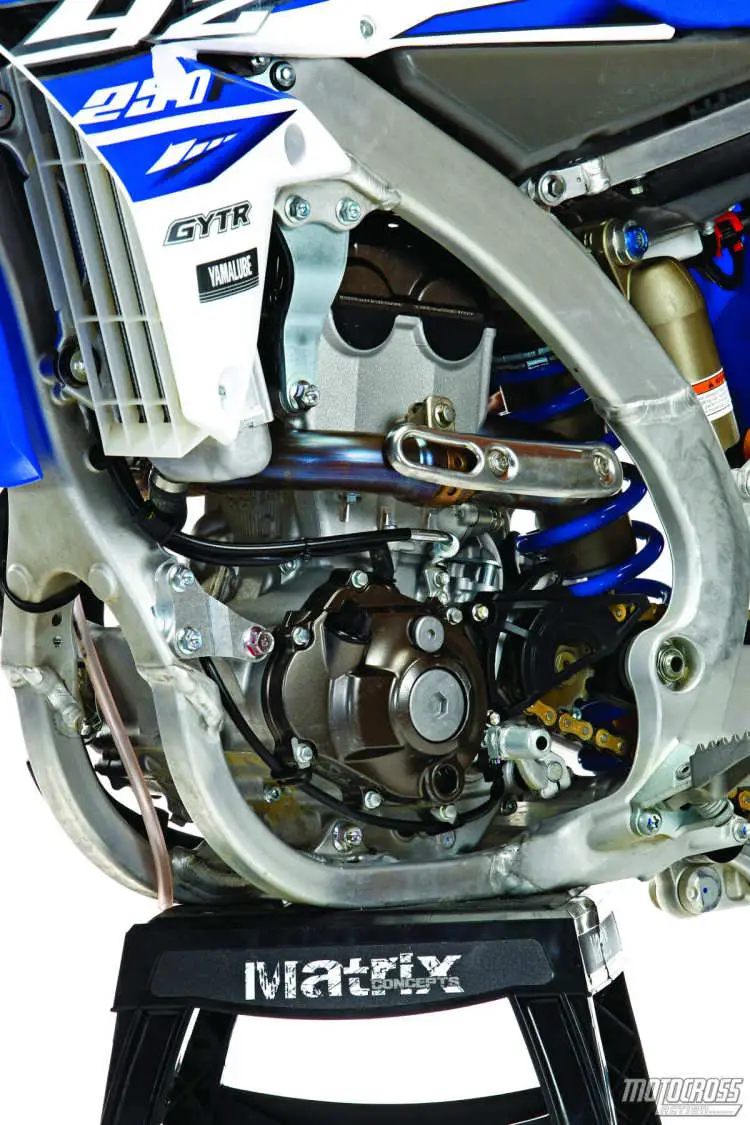
Q: WHAT DO WE HATE?
A: The hate list:
(1) Handlebars. The oversize handlebar bend and sweep isn’t our cup of tea. We opted for a slightly taller bar bend with a cross brace. Renthal makes a nice 997 TwinWall bend.
(2) Front brake. Honda and Kawasaki beefed up their front brake rotors. We were hoping that Yamaha would join the party. Sadly, the YZ250F’s 250mm front rotor is only a little better than Fred Flintstone’s feet.
(3) Exhaust pipe. The YZ250F is blessed with an excellent-performing stock exhaust system; however, if you decide to invest in an aftermarket system, then be ready to Harry Houdini the pipe to get it to fit.
(4) Vent hose. We don’t like the way Yamaha routs the gas cap vent hose. It’s an eyesore and ruins the otherwise sleek look of the cockpit. We rerouted the hose underneath the airbox cover and out the front. Consult the “Wrench Tech” feature in the October 2014 issue for a proper tutorial.
(5) Dzus fasteners. We’re pleased to see Dzus fasteners on the airbox, but we had to cut the D-rings off the ones on the side of the airbox, which meant that we needed a screwdriver to remove them. Thus, screws would have worked better in the first place.
Q: WHAT DO WE LIKE?
A: The like list:
(1) Engine. It’s quick enough for advanced skill levels, but it’s fast without being too much for slower riders. Very nice.
(2) Dyno. The 2015 YZ250F made 41.11 horsepower at peak — third best behind the KTM 250SX and Husky FC250. The YZ250F was well ahead of the Honda (37.30) and Suzuki (38.48) and Kawasaki (40.36)
(3) Suspension. In a market dominated by air forks, Yamaha stayed true to Kayaba SSS. Even after all these years, we still love the simple technology. Great stuff.
(4) GYTR Power Tuner. It’s intuitive, easy to use and changes engine performance in a matter of seconds. Do yourself a favor and invest in a GYTR Power Tuner.
(5) Tires. We’ve long had a love affair with Bridgestone’s 403/404 sneaker combo. The rubber works well in a variety of conditions and holds up well to abuse.
(6) Choices. Yamaha is the only manufacturer to offer a motocross model in two different colors. We prefer the blue-and-black combo, but the white-and-red motif is unique. Best of all, the price is the same ($7590) regardless of color.
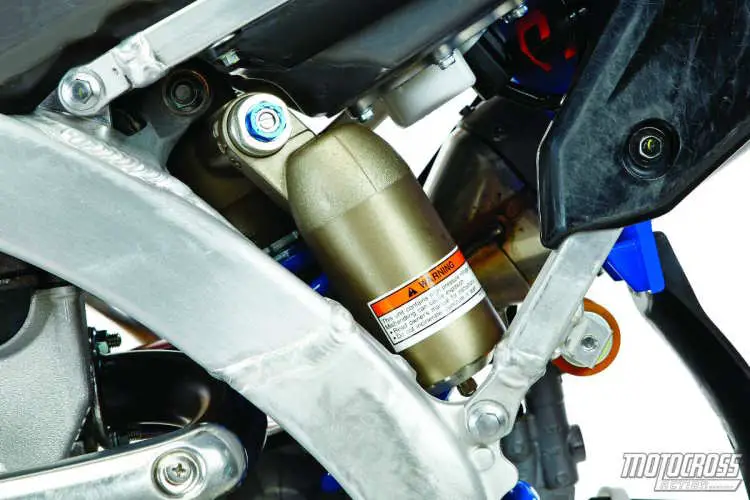
Q: WHAT DO WE REALLY THINK?
A: Oh, 2015 Yamaha YZ250F, how do we love thee? Let us count the ways. (1) Engine performance is awesome and suits a wide range of skill levels. It romps on the track and is far and away one of the best powerbands in the class. (2) The Kayaba SSS suspension is great out of the box, and it doesn’t take much effort to make it even better. (3) Handling traits have improved slightly since last year; the YZ250F is workmanlike across varied terrain and truly shines where there’s ample traction. (4) We haven’t encountered any durability issues on our stock engine test bikes. The 2015 Yamaha YZ250F shouldn’t merely be measured by its impressive powerband but by its entire body of work. This bike is a winner. ❏
MXA YAMAHA YZ250F SETUP SPECS
This is how we set up our 2015 Yamaha YZ250F for the track. We offer these settings to help steer you in the right direction.
KAYABA SSS FORK SETTINGS
Yamaha jumped up a spring rate last year, which was too stiff for featherweight riders. If that’s your case, we recommend dropping to a 4.5 N/mm rate and lowering the oil height in 5cc increments until the desired performance is met. Riders over 160 pounds, however, felt that the spring rate was sufficient. Yamaha’s goal was to improve the balance and stability in the front end. They succeeded, though it takes tinkering and patience to achieve the desired balance. Our best results came after softening up the compression and slowing down the rebound. These changes provided smoother bottoming resistance while preventing the front end from being too active when entering choppy corners.
For hardcore racing, we recommend this fork setup for the 2015 Yamaha YZ250F (stock specs are in parentheses):
Spring rate: 4.7 N/mm
Oil quantity: 335cc
Compression: 14 clicks out (10 clicks out)
Rebound: 10 clicks out (12 clicks out)
Fork leg height: 5mm up
Notes: As mentioned above, lighter riders will find comfort in lowering the oil height or, at worst, dropping down a spring rate. Also, be mindful of fork-leg height, as it’s instrumental in finding chassis balance.
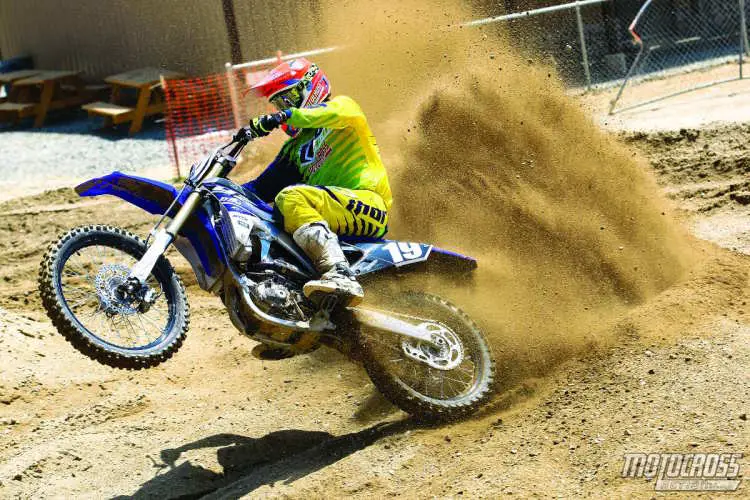
KAYABA SSS SHOCK SETTINGS
We were surprised to discover that the shock performance improved every time we softened up the low-speed compression. It was hard to digest the setting we preferred (21 clicks out), but our test riders raved about the result. Aside from that setting, we were close to the stock numbers. Use race sag to help balance out the chassis, but we don’t recommend dipping below 105mm.
For hardcore racing, we recommend this shock setup for the 2015 Yamaha YZ250F (stock specs are in parentheses):
Spring rate: 56.0 N/mm
Race sag: 102mm
Hi-compression: 1-1/4 turns out (1-1/3 turns out)
Lo-compression: 21 clicks out (10 clicks out)
Rebound: 10 clicks out (14 clicks out)
Notes: The shock has a tendency to hop under heavy braking and down rough straights. We slowed down the high-speed compression and softened up the low-speed compression.


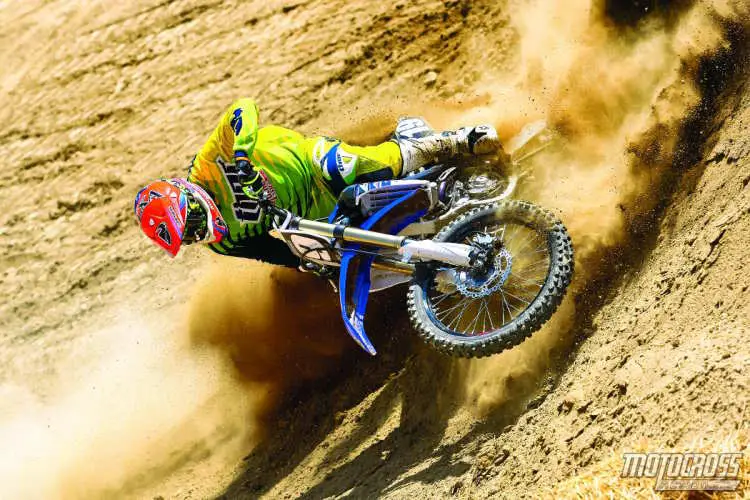





Comments are closed.